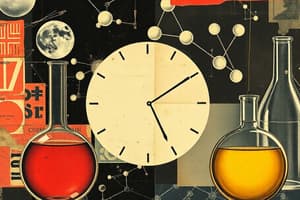Podcast
Questions and Answers
Which of the following describes a chemical change?
Which of the following describes a chemical change?
- Ice melting into water
- Water boiling to steam
- Bread turning into toast (correct)
- Dissolving sugar in water
Corrosion can destroy metals and human tissues.
Corrosion can destroy metals and human tissues.
True (A)
What is the primary environmental impact of harmful substances?
What is the primary environmental impact of harmful substances?
Damage to the aquatic environment or other environments.
A __________ mixture has particles that are not evenly distributed.
A __________ mixture has particles that are not evenly distributed.
Match the following indicators of a chemical change with their descriptions:
Match the following indicators of a chemical change with their descriptions:
Flashcards
What is Chemistry?
What is Chemistry?
The study of matter and its changes. It examines the composition, properties, and reactions of substances.
What is a Hazardous Material?
What is a Hazardous Material?
A substance that can cause physical harm, such as burns, corrosion, or poisoning.
What is a Physical Change?
What is a Physical Change?
A change in the physical form of a substance, but not its chemical composition. It's reversible.
What is a Chemical Change?
What is a Chemical Change?
Signup and view all the flashcards
What is a Homogeneous Mixture?
What is a Homogeneous Mixture?
Signup and view all the flashcards
Study Notes
Matter and its Classification
- Matter is anything that occupies space and has mass.
- Matter can be classified as pure substances (elements and compounds) or mixtures (homogeneous or heterogeneous).
- Pure substances: consist of only one type of particle.
- Elements: consist of only one type of atom.
- Compounds: consist of more than one type of atom.
- Mixtures: consist of more than one type of particle.
- Homogenous mixtures: particles are evenly distributed.
- Heterogenous mixtures: particles are not evenly distributed.
- Suspensions: particles settle slowly after mixing.
- Colloids: particles do not settle in a mixture.
- Emulsions: substances that suspend particles for a longer time.
Chemical Reactions and Changes
- Chemical changes involve the formation of new substances with different properties than the original materials.
- Physical changes do not involve the formation of new substances; the substance’s form or state changes, but its chemical composition stays the same.
- Chemical changes are not reversible.
- Physical changes can be reversed.
- Indicators of a chemical change:
- Heat is produced or absorbed.
- No more of the original material remains.
- Change in color.
- New properties are formed.
- Gas bubbles form in a liquid.
- A precipitate forms in a liquid.
- Difficult to reverse the change.
- Hard to explain how to reverse the change.
Properties of Substances and Hazards
- Substances can have hazardous properties that pose risks to the environment or human health.
- Gas cylinders under pressure can explode.
- Flammable substances can ignite and burn (flame).
- Oxygen can intensify a fire (flame over a circle).
- Exploding bombs release energy, fire, explosions and toxicants.
- Environmental hazards may damage the environment (e.g., aquatic environments).
- Corrosion: substances can destroy metals and human tissues
- High danger substances that can lead to immediate injury or death (corrosion skull and crossbones)
- Health hazards: substances can cause longer-term health effects.
- Hazardous substances that can cause minor health effects and ozone damage (exclamation mark symbol).
- Biohazard materials contain harmful microorganisms or toxins.
- Caustic materials: can cause chemical burns, corrode, or destroy organic tissues.
Studying That Suits You
Use AI to generate personalized quizzes and flashcards to suit your learning preferences.




